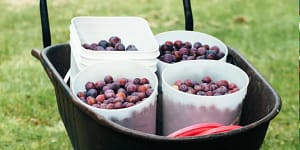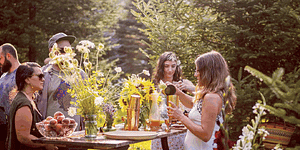On the Rise: How to Make Salt-Rising Bread

Want to spice up your traditional bread recipes? This salt-rising bread recipe by fermentation expert Sandor Ellix Katz has all the simplicity, flavor, and uniqueness you’ve been searching for!
The following is an excerpt from Sandor Katz’s Fermentation Journeys by Sandor Ellix Katz. It has been adapted for the web.
What Is Salt-Rising Bread?
Salt-rising bread is a very distinctive bread, risen not by yeast or salt, but by the bacteria Clostridium perfringens. Some may recoil with fear at the idea of eating a food fermented with this notorious bacteria, certain strains of which are associated with digestive illness, but microbiologists investigating salt-rising bread have found that the starters contain none of the toxins or genes associated with illness.
The starter for this style of bread is not perpetuated; it is made fresh for each batch. It involves very warm temperatures (ideally 104–110°F/40–43°C, but somewhat lower temperatures may work, too, only more slowly and less reliably), and a little bit of baking soda, not for its rising power but for its alkalinity. As the bacteria flourish in that warm, alkaline environment, the starter develops a strong cheesy smell, bordering on putrid at full vigor. But the putrid notes disappear in the baking, and the bread is very tasty indeed, especially toasted.
Salt-Rising Bread: A Unique and Rich History
Most of my information on and guidance for salt-rising bread comes from the excellent book Salt Rising Bread: Recipes and Heartfelt Stories of a Nearly Lost Appalachian Tradition, by Genevieve Bardwell and Susan Ray Brown. Their book is full of practical information about different ways to make salt-rising bread, but their greatest devotion is to the people carrying on this tradition, and their stories. “Without exaggeration, we can say that in the universe of breads, it stands alone,” they write.
There is nothing else remotely like it in terms of flavor, personality and technique. There is mystery about it in the wild microbes that cause it to rise. It has attitude and holds tantalizing secrets that have never been fully revealed. Sadly, very few people are alive today who know how to make this delicious yeastless bread the authentic way. That is the reason that we took it upon ourselves to be the chroniclers and preservers of this nearly lost tradition.3
They report that similar processes are also found for breads made in Greece and Sudan.
The Salt-Rising Fermentation Process
The salt-rising fermentation process consists of three distinct steps: preparing a starter, expanding it into a sponge, then expanding it further into firmer dough and forming it into loaves. I followed the basic outline of Pearl Haines’s recipe that Genevieve and Susan documented. Her method (described in detail below) calls for scalded milk poured over a mix of cornmeal, flour, and a tiny bit of baking soda. Other variants include potatoes (always peeled and with green flesh removed), sugar, salt, and boiling water rather than milk.
Genevieve and Susan offered a few tips for making salt-rising bread. They both emphasized the importance of temperature. “One of the biggest challenges, but also very important in making salt-rising bread, is keeping your starter at the right temperature (104–110°F/40–43°C),” explained Susan. “If it is too cool or too warm, the starter will not be successful.”4
I’ve used the oven with the pilot light lit as my incubation chamber, with great success. This is the same temperature range necessary for making yogurt, so any yogurt-making setup could be used, or a heating pad.
Salt-rising bread can take time. One batch I made was not active the morning after I started it, and I wondered whether something had gone wrong. A couple of hours later it was foaming. “You must pay attention, and you cannot hurry it along,” according to Pearl Haines, the elder whose starter recipe I followed.5
Though it cannot be rushed, the starter and sponge cannot be forgotten too long. “Use them while they are still active,” advises Susan. “If they go too long, they will lose their rising power and then your bread will not rise.”6
RECIPE: Salt-Rising Bread
Timeframe: Generally less than 24 hours
 Equipment
Equipment
- 2 loaf pans (roughly 8 1/2-by-4 1/2-by-2 1/2 inches OR 21-by-11-by-6 centimeters)
Ingredients
For two loaves
FOR THE STARTER
- 1/2 cup/120 milliliters milk or water
- 3 teaspoons cornmeal
- 1 teaspoon flour
- 1/8 teaspoon baking soda
FOR THE SPONGE
- 1 cup/135 grams flour
FOR THE DOUGH
- 11/2 tablespoons/25 grams salt
- 7 to 8 cups/1.1 kilograms flour (white, whole wheat, a mix of flours, or a gluten-free flour mix)
- Melted butter or vegetable oil for greasing pans and the tops of the breads
Process
-
- Heat the milk. Stir the milk as it heats; until tiny bubbles are forming, nearly but not quite at a boil. Then remove from the heat. If using water, bring to a boil.
- Mix together the cornmeal, flour, and baking soda in a small bowl or jar. Pour the hot milk or water onto the dry ingredients while it is still hot, and mix well. Most of the yeast and bacteria are killed by the hot liquid, but the Clostridium bacteria we are aiming to cultivate can survive the heat. If you use water rather than milk, add an extra teaspoonful of either cornmeal or flour.
- Loosely cover the starter to allow for gas exchange. I rest a small plate on it; if you use plastic or foil, poke a hole in it. Leave the starter in your warm incubation environment to ferment about 12 hours, until vigorously foamy.
- Prepare the sponge. In a large mixing bowl, combine the foamy starter with 1 cup/250 milliliters warm water in the same incubation temperature range and 1 cup/135 grams flour. Leave the sponge in the warm incubation space to ferment about 2 to 3 hours, until foamy.
- Prepare the dough. Add to the sponge 21/2 cups/600 milliliters incubation temperature water, salt, and 6 cups/900 grams of the flour, reserving about 11/2 cups/200 grams.
- Mix well, then add more flour, a little at a time, until the dough is easy to handle. Add as little of the remaining flour as necessary to reach this point.
- Knead the dough for a few minutes, then divide into two.
- Prepare the loaf pans. Brush melted butter or vegetable oil over all the interior surfaces, especially the corners.
- Form the loaves. Flatten one of the masses of dough, fold each side into the center, then roll it into a loaf shape and place in a greased loaf pan. Repeat with the second loaf. Brush melted butter or vegetable oil over the tops and exposed sides of the loaves.
- Final rise. Leave the loaves to rise for 2 to 3 hours in a warm environment (but not quite as hot as the starter or sponge, ideally about 100°F/38°C). Give them the time they need until you can see a substantial rise.
- Preheat the oven to 400°F/205°C.
- Bake the loaves for 30 minutes, then lower the heat to 350°F/175°C and bake for 15 minutes more. To test for doneness, remove a loaf from its pan and tap on the bottom of the loaf. If it sounds hollow, like a drum, remove the breads from the oven. If not, bake for 5 or 10 minutes more and test again.
- Cool the loaves on a rack.
Notes
3. Genevieve Bardwell and Susan Ray Brown, Salt Rising Bread: Recipes and Heartfelt Stories of a Nearly Lost Appalachian Tradition (Pittsburgh: St. Lynn’s Press, 2016), ix.
4. Personal communications with author.
5. Bardwell and Brown, Salt Rising Bread, 63.
6. Personal communications with author.
Recommended Reads
From the Garden to the Bread Basket: Rosemary Bread, Scones and Stuffing
Recent Articles
This recipe is a wonderful vessel for leftover pieces of vegetables, and offers a healthier alternative to traditional fries, with an added crunch from the panko. While the corn ribs recipe uses every part of the corn from husk to cob. The process takes hardly any time and can serve as an easy snack or side dish.
Read MoreThis simple syrup is straightforward and easy to make and use. Sage and lavender offer unique and complementary flavor profiles.
Read MoreFor those who love fermented foods, we now welcome you into the wonderful world of dilly beans. These snacks are the perfect addition to any meal.
Read MoreThis tried-and-true jam recipe relies on the natural sugars in fruit to provide a balanced flavor and sweetness that can’t be beat.
Read More
 Equipment
Equipment







